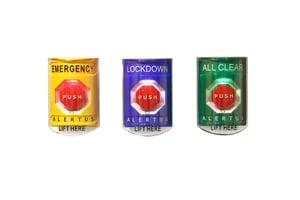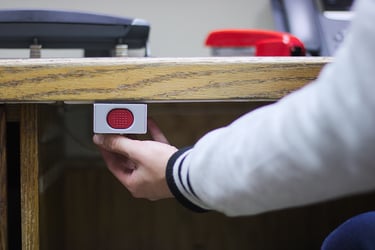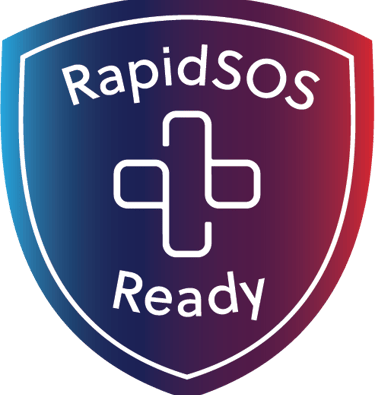Stay Safe
Learn how panic and duress buttons can protect you in emergencies.
Understanding Panic Buttons
Panic and duress buttons provide immediate alerts during emergencies, ensuring safety with a simple press.
50%
Response time reduced with duress alarm installations


Panic Buttons and Duress Alarm Systems








Introduction to Panic & Duress Systems
Panic buttons and duress alarm systems are emergency notification devices that, with one simple action (a button press or code entry), immediately alert security personnel and first responders to a crisis. In high-risk situations – whether an active shooter in a school, a medical emergency, or a staff member under threat – every second counts for saving lives. These systems are designed to expedite emergency response by cutting down the time it takes to call for help. In fact, studies show that duress alarms can reduce emergency response times by up to 50% by instantly notifying responders with critical details like location. Fast, direct alerts mean decisions such as initiating a lockdown or dispatching police and EMTs can happen without delay, dramatically improving outcomes.
Panic vs. Duress: The terms “panic button” and “duress button” are often used interchangeably. Both serve the same purpose – summoning help in an emergency – but there is a subtle distinction. A panic button usually refers to any manual emergency alarm (like a visible button under a desk or a mobile app icon) that anyone can press during a crisis. A duress button typically implies a more discreet or covert activation, used when a person is under threat and cannot obviously call 911. For example, entering a special duress PIN code on a door keypad (instead of a normal code) can silently trigger an alarm in a hostage situation. In practice, both panic and duress activations aim to immediately and silently communicate danger to those who can send help, all without raising the assailant’s suspicion in the case of duress. In the rest of this discussion, we will use “panic button” broadly to include all such emergency alarm triggers.
How Panic Buttons Speed Up Emergency Response
Traditional emergency reporting (like dialing 911 or calling security) takes time and may not be feasible in the midst of a crisis. Panic and duress buttons solve this by offering instant, one-step alerting. As soon as a button is pressed or a duress code is entered, an alarm is sent to pre-designated responders – this could be a security operations center on-site, all administrators’ phones, and often directly to local law enforcement dispatch. Many modern systems also transmit the exact location of the alert and even live information about the scene, enabling responders to make quick, informed decisions.
For example, in one school incident, wearable panic button devices carried by teachers allowed police to be notified within seconds of shots fired. As a result, officers arrived on site in under two minutes, and the shooter was apprehended only six minutes after the initial alert – a response speed credited with saving lives by halting the attack sooner. In everyday scenarios, panic alarms can also differentiate the level of response needed: a medical emergency might alert only on-site medical staff, whereas a confirmed threat like an armed intruder triggers a full law enforcement response. By pre-programming these actions, human decision-making time is minimized – the system automatically executes the emergency plan the moment a panic signal comes in.
Another key advantage is that panic/duress systems often integrate with other security technologies to provide rich situational awareness. When an alarm is activated, it can simultaneously lock or unlock doors, activate strobe lights or public address announcements, pull up nearby surveillance camera feeds, and send mass notifications to building occupants. For instance, some solutions will automatically display the live video from cameras in the area where a panic alarm was triggered, giving first responders real-time eyes on the scene. This unified response not only speeds up decision-making but also helps avoid confusion – everyone receives a consistent emergency message and knows how to act immediately.
LenelS2 – Integrated Duress in Access Control
As a leading access control platform, LenelS2 (now part of Honeywell) supports robust duress and panic alarm capabilities within its systems. Many administrators know LenelS2 for its badge entry and door security features, but it also offers built-in emergency alert functions. For example, LenelS2’s OnGuard system allows programming a special duress code on card reader keypads. If an employee is forced by an intruder to unlock a door, they can enter their duress PIN instead of the normal PIN. This will still appear to grant access, but silently triggers an alarm in the security monitoring software. Security officers are instantly notified of the duress event and can respond or call police, all while the aggressor remains unaware that an alarm was raised. This covert panic feature is crucial for scenarios like bank tellers or front-desk staff being coerced by a threat actor.
LenelS2 systems also integrate with hardware panic buttons and sensors. Panic buttons can be wired into the LenelS2 alarm inputs or connected via integration modules, so that pressing a physical emergency button at a reception desk or classroom sends an immediate alert through the OnGuard platform. The alert can be configured to pop up on security monitoring stations and even notify external authorities. Because LenelS2 is a comprehensive security management system, a panic alarm can trigger automated actions: for instance, locking all doors in a vicinity, triggering a lockdown message on the intercom, and pulling up camera views of the area, all coordinated through the OnGuard interface. By leveraging LenelS2’s integration capabilities, organizations get a unified response – the panic alarm isn’t an isolated system, but part of the overall security ecosystem (access control, alarms, video, comms) that works together to mitigate the threat swiftly.
Key LenelS2 Duress Features:
Silent Duress Codes: Users can enter a duress PIN at card readers to trigger alarms without raising suspicion. The alarm is sent to security monitoring instantly, and doors can optionally deny entry to slow an intruder.
Panic Alarm Inputs: Support for hardwired panic buttons or wireless fobs that tie into the LenelS2 controller inputs. These can be placed in strategic locations (front offices, classrooms, cashier stations) so that staff under threat can summon help with one touch.
Alarm Monitoring & Dispatch: All duress events show up in the LenelS2 alarm monitoring console in real time. The system can be configured to notify law enforcement directly or to display specific instructions for operators (e.g., “Code Red in Building A, Room 101”). This ensures that the right people are alerted immediately and can initiate the emergency response plan.
Integrated Response Actions: LenelS2’s platform can automatically execute response actions upon a panic alarm. For example, triggering facility-wide lockdown procedures, activating strobes or sirens, and integrating with mass notification systems to alert all personnel. Because the panic alarm is part of the access control system, it can also tie into video surveillance – security cameras near the alarm can pop up on screen, giving responders critical visual information without having to manually search for feeds.
Overall, LenelS2’s duress and panic features make it a powerful tool for security teams. It transforms the access system into an emergency communication network: the same badges and readers used for daily access control can double as life-saving alert devices. Administrators and security directors appreciate that this leverages existing infrastructure (readers, software) to add a vital safety layer with minimal complexity.




Alertus – Instant Mass Notification at the Push of a Button
Alertus Technologies specializes in emergency mass notification, and one of their hallmark offerings is a comprehensive suite of panic button solutions. These solutions are all about getting the word out instantly to everyone who needs to know about an emergency, from first responders to all building occupants, using any and all available channels. Alertus supports multiple types of panic activators – hardwired wall buttons, wireless wearables, USB-connected buttons, and software-based triggers – giving organizations flexibility to deploy the right device for each scenario.
When an Alertus panic button is pressed, it doesn’t just send a quiet alarm to one console; it can blast out a coordinated alert across a wide range of notification endpoints. In a split second, the Alertus system can flash warnings on wall beacons and LED marquees, pop up override alerts on desktop computers, push emergency messages to mobile phones via apps or text, take over PA systems with text-to-speech announcements, activate digital signage to display instructions, and send mass emails/SMS – all at once. This one-button chain reaction ensures that everyone in the facility or campus is informed immediately, which is critical for guiding people to safety while simultaneously alerting authorities.
Alertus panic buttons can be configured with custom preset alerts and event triggers. For example, a school might have one panic button labeled “Active Shooter” that, when pressed, automatically locks down the school, texts all teachers to shelter in place, notifies 911 and district police, and flashes strobe lights in hallways – whereas another button labeled “Medical Emergency” might quietly summon the school nurse and front office team to a specific room without causing a broader alarm. Multiple alerts can be launched from a single button press as well, targeting different audiencesalertus.com. This means a teacher’s wearable panic fob could simultaneously send a detailed alert to administrators (“Emergency in Room 12, Second Floor, Building B”) and a more general alarm to the rest of the school (“Lockdown initiated, remain in place”).
The hardware options from Alertus cover many use cases:
Wireless Wearable Panic Button: A small WiFi-enabled device on a lanyard that staff can carry. Pressing it shares the user’s identity and location with responders. This is great for roaming staff like teachers on playground duty or maintenance workers who aren’t near a fixed button.
USB Desktop Panic Button: A console with multiple programmable buttons that connects via USB. Often placed at reception desks or security offices, it allows staff to quickly choose the nature of the emergency (intruder, fire, medical, etc.) and send the appropriate alert with one touch. Its discreet design helps prevent false alarms.
Wall-Mounted Activation Buttons: Durable, color-coded push buttons that can be installed in classrooms, hallways or common areas. These can trigger immediate lockdown alerts or facility-wide alarms. They’re designed with protective covers or recessed buttons to avoid accidental activation.
Software Panic Button: Alertus also provides a software-based panic button (e.g. a hotkey or on-screen icon on any computer) as part of their Desktop Notification system. This means any staff member at a PC can silently trigger an alert without needing a separate device – an important option if, say, an intruder is in the front office and the secretary can’t reach under the desk, but can click an on-screen emergency icon.
Why Alertus for Panic? The strength of the Alertus approach is integration and speed. Because it ties into a full mass notification ecosystem, that single button press immediately activates all communication channels with a pre-designed message. There is no time lost in someone manually calling or typing out an alert to everyone – it’s pre-scripted and automated. This rapid, wide-reaching communication helps decision-makers too: if you’re a security director receiving the panic alarm, you know that simultaneously the campus population has been instructed on what to do. You can focus on coordinating with first responders, since the notifications to evacuate, lockdown, or avoid the area have already been handled by the system. It creates a more coordinated emergency response where everyone is on the same page almost instantly.


OpenPath (Avigilon Alta) – Mobile Lockdown and First Responder Integration
OpenPath, now part of Motorola’s Avigilon Alta platform, is a modern, cloud-based access control system known for its smartphone-based credentials and IoT-friendly design. OpenPath brings a unique strength to emergency situations: the ability to initiate site-wide lockdowns or emergency actions from anywhere, instantly, using a mobile app or integrated triggers. Rather than relying solely on fixed panic switches, OpenPath enables authorized users (like school administrators or office security managers) to declare an emergency and secure the facility with just a couple taps on their phone.
OpenPath’s Lockdown Solution allows pre-configured emergency modes (for scenarios like active shooter, bomb threat, or severe weather). When a lockdown is triggered, the system can lock or unlock every specified door, restrict access to only emergency personnel, and override normal entry rules within seconds. What’s powerful is how these lockdowns can be triggered: OpenPath integrates with a wide range of third-party panic activators and sensors, including gunshot detection systems, glass-break sensors, Amazon AWS IoT panic buttons, traditional wired panic buttons, and mobile phone commands. In practice, this means a teacher pressing a wireless panic fob, a frontline employee double-pressing a wearable badge, or even an AI gunshot detector picking up a firearm discharge can all send a trigger to OpenPath, which automatically launches the emergency lockdown plan. The ability to ingest triggers from various devices makes OpenPath’s duress response very flexible – it’s not tied to one type of button.
Once a lockdown or panic event is activated in OpenPath, the system goes to work to assist emergency response. It can immediately alert first responders via text or email that a critical incident is happening. Because OpenPath is cloud-connected, it can also share data with other safety systems. Notably, OpenPath partnered with video surveillance platforms (like Camio and Avigilon CCTV) so that when a panic/lockdown is triggered, a live video feed of the affected area is sent to law enforcement and security stakeholders. This real-time video, along with a digital map of the facility, helps police and rescue teams assess the situation on the way to the scene, speeding up their decision-making on how to respond. As Campus Safety Magazine reported, sending live camera feeds to first responders during a lockdown was a “brilliant addition” that gives responders immediate insight behind the school or office walls.
OpenPath also emphasizes an important scenario: mobility. In an emergency, one might not be able to reach a wall-mounted alarm if they are hiding or running. With OpenPath, any administrator’s smartphone becomes a panic button – you could trigger a lockdown while taking cover in a closet, for example. This mobile-first approach ensures that no matter where the crisis starts, help is one touch away, even if you aren’t near a physical alarm switch. And because the system is cloud-based, even remote personnel can activate or manage a lockdown. A district security officer at headquarters could initiate a panic lockdown at a school campus the moment an alert comes in, in parallel with on-site actions.
OpenPath Emergency Features at a Glance:
Mobile App “Lockdown” Command: Designated users can instantly invoke emergency lockdown plans from their phone. This immediately secures doors and notifies all users who need to know. The mobile app removes the constraint of having to be in a specific location to trigger an alarm.
Third-Party Panic Device Integration: OpenPath accepts triggers from hardware panic buttons, wireless fobs, and sensors. For instance, a wireless panic button installed under a receptionist’s desk or a wearable duress badge can be connected to the OpenPath system; when pressed, it will kick off the same lockdown/alert procedures as a manual app trigger.
Automated Alerts with Video:* When an emergency is activated, OpenPath can automatically send out alerts to first responders (911 center, campus police, etc.) with critical details. Through integrations, it shares live video from on-site cameras and even can provide floor plans or location information to help authorities respond faster. This bridges a gap between access control and situational intelligence – it’s not just locking doors, but actively helping responders make informed decisions.
Customizable Response Plans: Administrators can pre-define multiple emergency scenarios (active assailant, medical emergency, chemical spill, etc.) with tailored actions for each. This means the system knows exactly which doors to secure, who to notify, and what message to broadcast depending on the event type, all triggered by that single panic activation. It provides flexibility, since a one-size-fits-all alarm might not be appropriate for every situation.
Through these capabilities, OpenPath (Avigilon Alta) offers a holistic approach to duress alarms, combining physical security (doors and alarms) with digital intelligence (cloud connectivity, video, mobile). For security teams and facility managers, this means when the unthinkable happens, the response is unified and instantaneous – lockdown measures deploy at once and accurate information flows to those who need it.
Conclusion
For school administrators, security directors, and facility managers, panic and duress buttons have moved from a “nice-to-have” extra to a critical component of emergency planning. The ability to expedite emergency response decisions with the press of a button can save lives and dramatically improve the outcome of crises. Whether it’s through an integrated access control system like LenelS2, a mass notification platform like Alertus, or a mobile-enabled lockdown system like OpenPath, there are solutions available today to fit every organization’s needs and infrastructure. These technologies ensure that when an emergency occurs, help is on the way immediately and the people in danger are alerted and protected as fast as possible.
Furthermore, the push from state laws (such as Connecticut’s funding initiative and Florida’s Alyssa’s Law requirement) and national safety standards (PASS guidelines) means that panic alarms are not just an internal consideration, but a recognized best practice backed by policy. Schools and public facilities are increasingly expected to implement these measures for the safety of their students, staff, and visitors. By adopting panic and duress buttons – and training your team on their use – you empower your institution to respond to the unthinkable with speed, coordination, and efficacy.
In summary, panic button systems offer peace of mind in an age of complex safety challenges. They give administrators and security teams a consultative, easy-to-use tool that works in the background but stands ready to perform in the worst moments. Investing in a duress alarm capability, especially one that integrates with your broader security ecosystem, is an investment in the safety and trust of your community. With the support of our partners LenelS2, Alertus, and OpenPath, we can help you design and implement a panic alarm solution tailored to your environment – one that meets modern safety standards and, most importantly, helps keep people safe when every second counts.
FAQs
What is a panic button?
A panic button is a device that instantly alerts help during emergencies.
How do duress buttons work?
Duress buttons send silent alerts to security or authorities when pressed.
Where are panic buttons commonly used?
They are often installed in workplaces, schools, hospitals, and public spaces for quick emergency response.
Can panic buttons be wireless?
Yes, many modern panic buttons operate wirelessly for easy installation.
Who should use duress buttons?
Anyone in high-risk jobs or situations can benefit from using duress buttons.
These panic buttons gave our staff peace of mind during emergencies.
J. Smith


★★★★★
Contact
Reach out for tailored tech solutions.
Phone
203.387.6664
© 2025. All rights reserved.
Licensed & Insured: CT: ELC.0205738-E1
Licensed & Insured: FL: EF20002165
Licensed & Insured: GROL: PGGB056207

